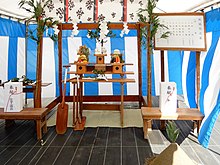Jichinsai
Jichinsai is a festival in Japanese culture. It happens before construction starts on a new building.[1][a]

People do the ritual to ask for permission from the landlord deity to make a building on their land.[2]
It is a way to pray for safety during the construction. The contractor, who makes the building, pays for the festival. This includes the omiki and tamagushi offerings. The owner and other people involved help pay, too.[3] People set up a Himorogi at the space in order to do the ceremony.[4]
The ceremony is held in the presence of builders, designers, and clients. A wooden platform is set up, and in the center is an altar on which offerings such as rice, sake, fish, vegetables, salt, and water are placed. In some cases, sand or salt from the beach near Ise Grand Shrine may be used.[1] Five-colored silk banners, called Masakaki, are used in the ritual.
Tsu Jichinsai Lawsuit
changeThe Tsu Jichinsai lawsuit in 1971 declared the rite secular.[5]
Jichinsai ceremony in agriculture
changePeople often pray to the land gods for a bountiful harvest and protection during farming activities. In the beginning of spring, they pray for a successful harvest and safety, while in early autumn, they express gratitude for a good harvest and pray for safety in the upcoming year. This ceremony is usually attended by farmers and is held at a nearby shrine managed by the community or at a location with a rope tied to a rock.
Jichinsai ceremony in Buddhism
changeIn Buddhism, there is a practice called jichinho, chintaku ho, anchinho, jitenku, or jimatsuri, which is commonly known as a ground-breaking ceremony. In esoteric Buddhism, there is a ceremony called Chintaku Fudoho where Fudo Myo-o is the principal image. This ceremony is performed before building a hall, a Buddhist pagoda, or a tombstone, where a boundary is formed on the land. The ceremony is centered on the earth and heaven, and involves the heavenly gods and death gods. It is held to prevent hindrance from the dead souls and to requisition them forever.
When constructing a hall, there is a method called chindanho, where the altar is built without laying a plank. The ground and chindan (altar) are then repaired separately. Sometimes both methods are used simultaneously. A kenbo containing five treasures and seven treasures is buried in the center of the altar, and a flat stone called chinseki is placed on it. The eight directions are then filled with rings, kui, and five balls.
In the Nichiren Shoshu sect, the ground-breaking ceremony is held as a "construction ceremony" to purify the land with the power of the principal image and to pray for the safety of the construction. The ceremony involves setting up an altar at the center of the construction site and raising the principal image of the temple that will be built.
Steps of Jichinsai
changeThe general flow of Shinto groundbreaking ceremonies is as follows.
- Chozuya (手水)
- Before entering the venue of the Shinto ritual, wash your hands with water scooped from the wash basin to purify your mind and body.
- Harae (修祓)
- After the opening ceremony, prior to the main ritual of the festival, a ceremony to purify the attendees and offerings.
- Koshin (降神)
- A ceremony to welcome the gods of the land and the tutelary gods of the region to the shrine set up on the altar. A Shinto priest announces the advent by uttering “Ooo~” (saying “Keihitsu”).
- Kensen (献饌)
- A ceremony to have the god eat the offerings of the altar.
- Norito Sojo (祝詞奏上)
- Tell the god that you will build a building on that land, and pray for the safety of the subsequent construction.
- Kiyoharai Sanku (清祓・散供)
- Purify the four corners of the land and sprinkle rice, salt, and hemp on them. It is also called Kirinusa or Sanmai.
- Jichin (地鎮)
- Kusakarisome using an imikama, ugachizome using an imikuwa, and burial of shizumemono are performed.
- Tamagushi Worship (玉串拝礼)
- Offering a Tamagushi to the altar and praying. Tamagushi is made by attaching paper strips and cotton to Sakaki trees.
- Withdrawal (撤饌)
- Lower your offerings.
- Shoshin (昇神)
- Ceremony to send the god who descended to the shrine to the original throne. A closing ceremony will follow.
Naorai
changeAfter the Shinto groundbreaking ceremony is completed, a Naorai meeting is usually held. During the Naorai, participants share sacred sake and enjoy the leftovers from the offerings. In addition to the Shinto ritual, a casual gathering may be arranged where beer, boxed lunches, and other refreshments are provided. Alternatively, participants may rent a banquet hall at a restaurant to celebrate with a feast.
Izumo mansion
changeThe Izumo Taisha holds a special Shinto ritual known as "Izumo Yashiki (出雲屋敷)" to honor the Okuninushi, the supreme deity of the land, and pray for the peace and stability of the land. During this ritual, the 'Goshinto', which is the soil of Izumo Taisha, is buried in the mansion, making it a place ruled by Okuninushi Okami. This is said to eliminate demon gates, attacks, azimuths, and obstacles, leading to prosperity. The traditional rituals of Izumo Taisha are followed, including special features such as three chanting of divine words, burial of sacred soil, and four clapping. After the Izumo mansion, the Izumo annual tribute is offered, and some first fruits are donated every year.[6]
Related pages
changeNotes
change- ↑ Except for Ise Grand Shrine where it occurs after[1]
References
change- ↑ 1.0 1.1 1.2 https://archive.today/20230417215042/https://d-museum.kokugakuin.ac.jp/eos/detail/?id=8916
- ↑ Adriana (2017-12-12). "Before you build: Groundbreaking ceremonies in Japan". REthink Tokyo - Real Estate Information for Buyers and Investors. Archived from the original on 2023-05-03. Retrieved 2023-05-03.
- ↑ Covingtonandsons. "Supernatural Stuff". Covington & Sons Tools. Retrieved 2023-04-18.
- ↑ "Ji Chin Sai - Ground breaking Ceremony". www.shinto.nl. Retrieved 2023-05-03.
- ↑ "Details of 1971 (Gyo-Tsu) 69 | Judgments of the Supreme Court". www.courts.go.jp. Retrieved 2023-05-03.
- ↑ 『出雲大社教布教師養成講習会』発行出雲大社教教務本庁平成元年9月1日全218頁中230頁